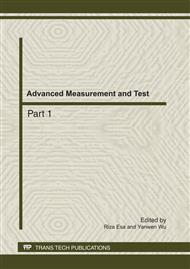[1]
M.R. Schroeder. Determination of the Geometry of the Human Vocal Tract by Acoustic Measurements. J. Acoust. Soc. Am., Vol. 41(4), 1002-1010 (1967).
Google Scholar
[2]
P. Mermelstein. Determination of the Vocal-Tract Shape from Measured Formant Frequencies. J. Acoust. Soc. Am., Vol. 41(5), 1283-1294 (1967).
DOI: 10.1121/1.1910470
Google Scholar
[3]
M. EI-Raheb and P. Wagner. Acoustic propagation in rigid ducts with blockage. J. Acoust. Soc. Am., Vol. 72(3), 1046-1056 (1982).
Google Scholar
[4]
Qunli Wu and Fergus Friche. Determination of blocking locations and cross-sectional area in a duct by eigenfrequency shifts. J. Acoust. Soc. Am., Vol. 87(1), 66-75 (1990).
DOI: 10.1121/1.398914
Google Scholar
[5]
M.H.F. De Salis and D.J. Oldham. Determination of the Blockage Area Function of A Finite Duct From A Single Pressure Response Measurement. J. Sound and Vib., 221(1), 180-186 (1999).
DOI: 10.1006/jsvi.1998.1965
Google Scholar
[6]
M H F de Salis, B M Gibbs & D J Oldham. The location and identification of defects in pipes and ducts by means of resonance and anti-resonance shifts. CD-ROM Proc. of Institute of Acoustics Spring Conference, Salford University, Salford (2002).
Google Scholar
[7]
Y. Yin and K. V. Horoshenkov. Attenuation of the higher-order cross-sectional modes in a duct with a thin porous layer. J. Acoust. Soc. Am., Vol. 117 (2), pp.528-535, February (2005).
DOI: 10.1121/1.1823211
Google Scholar
[8]
N.N. Voronina, K.V. Horoshenkov. A new empirical model for the acoustic properties of loose granular media. Appl. Acoust., Vol. 64(4): 415-432(2003).
DOI: 10.1016/s0003-682x(02)00105-6
Google Scholar
[9]
K. V. Horoshenkov and M. J. Swift. The acoustic properties of granular materials with pore size distribution close to log-normal. J. Acoust. Soc. Am., Vol. 110 (5), 2371-2378 (2001).
DOI: 10.1121/1.4809157
Google Scholar
[10]
Morse, P. M and Ingard, K.U. Theoretical Acoustics. Princeton University Press. Princeton (1986).
Google Scholar
[11]
F. Tisseur and K. Meerbergen. The Quadratic eigenvalue problem. SIAM Review, Vol. 43(2), 235-286 (2001).
DOI: 10.1137/s0036144500381988
Google Scholar


